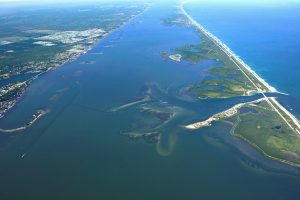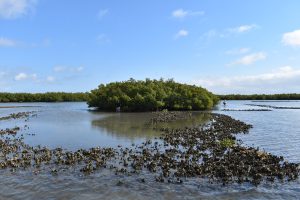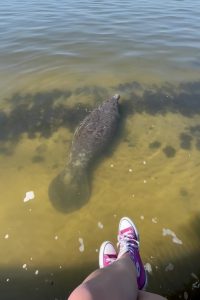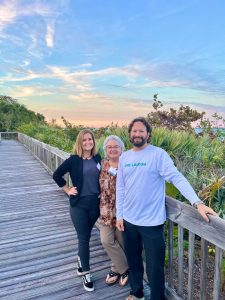This blog was written by the Indian River Lagoon National Estuary Program in Sebastian, Florida.
Take a journey with us along the picturesque eastern coast of Florida, where one of America’s most biodiverse estuaries of national significance is found – the Indian River Lagoon. This impressive ecosystem spans 156 miles, housing over 4,300 species of plants and animals. The Indian River Lagoon is a group of three lagoons: the Mosquito Lagoon, the Banana River, and the Indian River, with a watershed that includes five state parks, four wildlife refuges, and a national seashore.
History of the Indian River Lagoon
Known to locals as “the IRL,” this estuary provides Florida with over $7.6 billion annually through ecotourism, the marine industry, defense and aerospace, and living resources. Home to Kennedy Space Center, the IRL is steeped in rich cultural history. Since 1968, the Kennedy Space Center has been NASA’s primary launch center for human space flight, including the Apollo program of the 60s and 70s, the space shuttle program of the 80s and 90s, and commercial spaceflight through SpaceX today.

The IRL’s history dates back over 10,000 years to the Native American tribes that lived in the region. The Indian River Lagoon was named for the Ais, or Ays, Native American people of eastern Florida. The Indian River was known as the “River of Ais” to the Spanish settlers who settled in the area in the 1500s. The Ais were hunter-gatherers and food was plentiful, with the main staple of their diet being shellfish. The discarded shells were piled into massive mounds that are still present today along the coastlines.
Current State of the Indian River Lagoon
While the IRL has a fascinating past, it has faced some significant environmental challenges in recent years. Due to unconstrained coastal development, stormwater runoff, leaking septic tanks, and an increase in fertilizer use by Florida’s many new homeowners, the estuary has suffered from eutrophication and decades of algae blooms. The invasive Aureoumbra lagunensis, Texas brown tide, and cyanobacteria from government-released Lake Okeechobee overflow have caused major issues in the Indian River Lagoon watershed, leading to fish kills and the loss of 95% of the system’s seagrass.

But don’t despair – there’s hope on the horizon! Since 1990 when the IRLNEP was formed by the U.S. EPA, the program has been working to protect and restore the Indian River Lagoon. This program is a collaborative effort between federal, state, and local government agencies, non-governmental organizations, and the public to protect the lagoon’s water quality, habitats, and species.

Looking to the Future
The IRLNEP has set some ambitious goals for the future, which include reducing nutrient pollution in the lagoon; restoring and protecting critical habitats such as seagrasses, mangroves, and oyster reefs; controlling and managing invasive species; and preparing for and adapting to the impacts of climate change. And let’s not forget about community engagement. The IRLNEP recognizes the importance of engaging with the community to promote awareness of the importance of the Indian River Lagoon. The program also encourages public participation in efforts to protect and restore the ecosystem.

So, let’s get excited about what the future holds for the Indian River Lagoon! Achieving these goals will require collaboration between government agencies, non-governmental organizations, and the public. With a sustained effort to address the complex environmental challenges facing the lagoon, we can protect and restore this vital ecosystem. After all, the Indian River Lagoon is not only a critical habitat for many species, including manatees, dolphins, and seagrasses. It is also a place with a rich cultural history and an ever-growing human population that relies on the lagoon for its quality of life and economic benefits. The IRL deserves our protection and care.
Visit the IRLNEP website at Onelagoon.org to learn more about what they do and how you can support their work!
Help us protect and restore the Morro Bay estuary!
- Donate to the Estuary Program today and support our work in the field, the lab, and beyond.
The Estuary Program is a 501(c)3 nonprofit. We depend on funding from grants and generous donors to continue our work. - Support us by purchasing estuary-themed gear from ESTERO. This locally owned and operated company donates 20% of proceeds from its Estuary clothing line and 100% of Estuary decal proceeds to the Estuary Program. Thank you, ESTERO!
- Purchase items from the Estuary Program’s store on Zazzle. Zazzle prints and ships your items, and the Estuary Program receives 10% of the proceeds. Choose from mugs, hats, t-shirts, and even fanny packs (they’re back!) with our fun Estuary Octopus design, our classic Estuary Program logo, or our Mutts for the Bay logo.
- We want to hear from you! Please take a few minutes to fill out this short survey about what type of events you’d like to see from the Estuary Program. We appreciate your input!